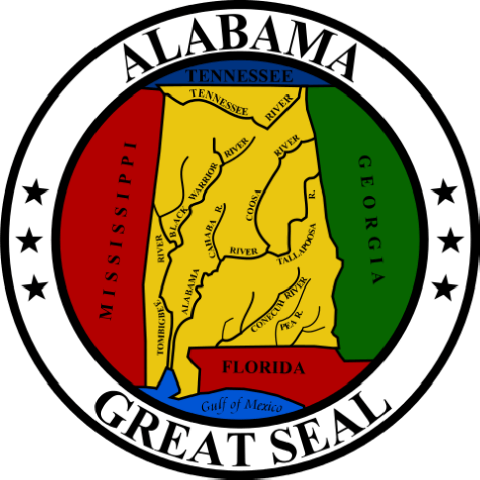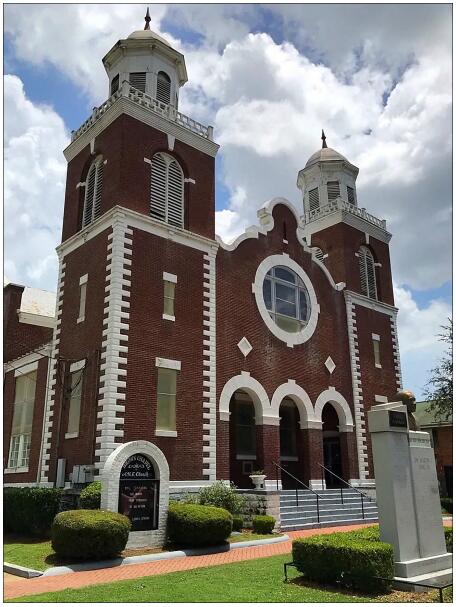| Area | 135,293 km² |
| Residents | 4,863,300 |
| Residents per km² | 35.9 |
| Capital | Montgomery |
| Postal Code | AL |
| ISO-3166-2 code | US-AL |
| FIPS code | 01 |
Also known as Yellowhammer State / The Cotton State / The Heart of Dixie, Alabama is short for AL with a population of 4,447,100. The capital city of Alabama is Montgomery and the biggest city is Birmingham.
Alabama is a state of the United States, which is one of the southern states.
The name “Alabama” goes back to the French name of the Indian tribe from the Muskogee language family known today as the Alabama. They called them ” Alibamons ” in an attempt to reproduce a word from the Choctaw language that sounded similar to their ears. This word in turn denoted the activity of cutting and gathering herbs or grasses.
Alabama has the unofficial surname Cotton State, then Yellowhammer State (German gold woodpecker state ), after all it is often referred to as the Heart of Dixie (German heart of the south ).
With an area of 135,765 km², Alabama ranks 30th among the US states. It is bordered by Tennessee to the north, Georgia to the east, Mississippi to the west, and Florida to the southeast.
To the northeast are the stony Appalachian Mountains, and between the Coosa River and Auburn the Piedmont plateau with red, ferrous clay soil; in the south and west lies the predominantly sandy coastal plain of the Gulf of Mexico. The area around Montgomery and Selma has particularly fertile, dark alluvial soil. Much of the area of the state is covered by forest. In the south lies the Gulf of Mexico, into which the main Alabama River flows. Alabama’s 67 counties ( counties divided).
Economy
Alabama consists of 50 percent pine and deciduous forests, which is why it also has a large forest and timber industry.
The industrial part of the state ‘s economy in the 19th and 20th centuries was primarily based on the textile industry (mostly cotton) and cement, and there was also an iron and steel industry in the Birmingham area, where iron ore is more abundant.
In the meantime, car construction (Daimler plant Mercedes-Benz US International in Vance / Tuscaloosa County, Honda plant in Lincoln and Hyundai in Montgomery) and technology (NASA in Huntsville) are playing an increasing role. The establishment of new industrial companies is opposed to the stricter immigration policy of this state.
Most of the Alabama River plains are used for agriculture, especially cotton, corn, sugar cane, tobacco, potatoes and fodder crops. In the animal breeding sector, mainly cattle and pigs are kept.
Southern States
In a narrower sense, the term describes the eleven of the slave-owning states that split off from the Union in 1860/1861. Lincoln hadn’t called for the abolition of slavery because it was a state matter, but the Northern Republican proved that someone could be elected president without the support of the South. The eleven states formed the Confederate States of America, but were subject to the Northern States in the Civil War (1861-1865).
According to the United States Census Bureau, the southern states consist of a total of 16 states with almost 100 million inhabitants on 2,384,143 km². These are those more eastern states that lie south of the Mason-Dixon Line, the border between Pennsylvania and Maryland, and in which slavery was allowed until 1865. The most populous of these states is Texas.
The southern states (also called Dixieland) in the broader sense are a specific cultural region in the southeastern United States.
There are several definitions or classifications of the southern states:
- Often the southern states are simply equated with the states in which slavery was allowed. However, this was still the case in some New England states around 1800.
- Southern states are those states that renounced the Union or joined the Confederate States in 1860/1861. These were all slave-holding states, but some slave-holding states stayed with the north: Missouri, Kentucky, Maryland, Delaware. West Virginia broke away from Virginia in the Civil War and joined the north in 1863. The founding states of the Confederate States were South Carolina, Mississippi, Florida, Alabama, Georgia and Louisiana, later joined by Texas, Virginia, Tennessee, Arkansas and North Carolina.
- Old South: The east coast states of Delaware, Maryland, Virginia, North Carolina, South Carolina and Georgia, i.e. the (slave-holding) southern states when the USA was founded.
- Upland South or Upper South refers to the northern parts of the southern states, especially those that joined the Confederate States after they were founded: Texas, Virginia, North Carolina, Tennessee and Arkansas. In a broader sense, one can also add the states that remained in the Union.
- Deep South: The southern states of South Carolina, Georgia, Florida, Alabama, Mississippi, and Louisiana.
- Lower South: This term is either equated with the Deep South, or, according to the historian Ira Berlin, narrowed to the southeastern states of South Carolina, Georgia and Florida.
- The District of Columbia, the capital Washington, was still familiar with slavery in 1860. Seen in this way, the district can be counted among the slave-holding areas that have not joined the Confederates.

